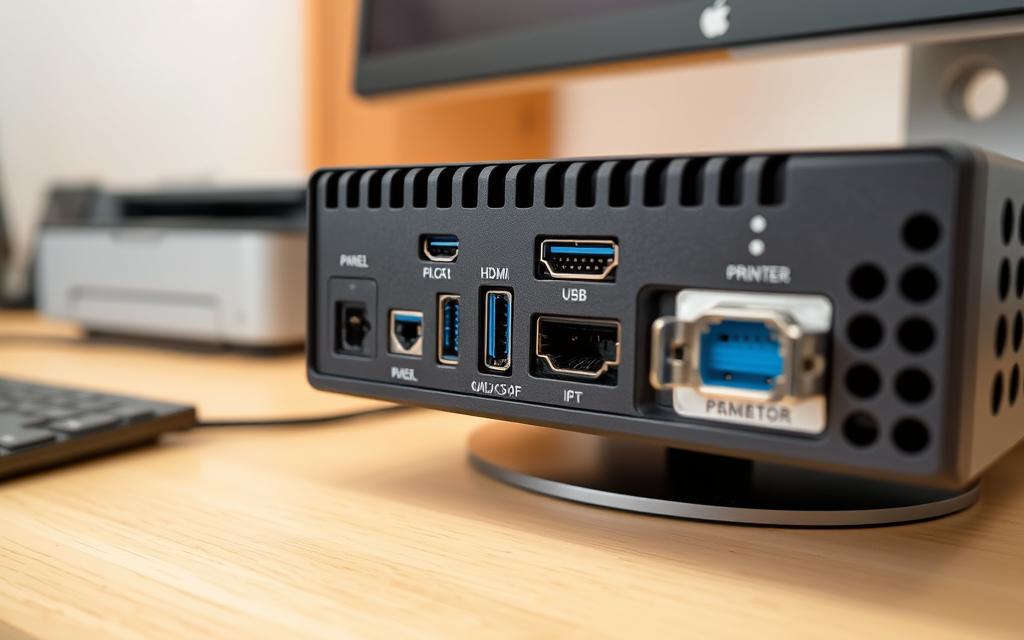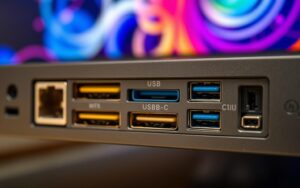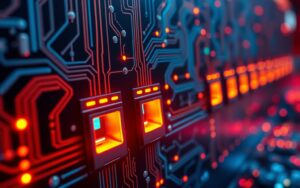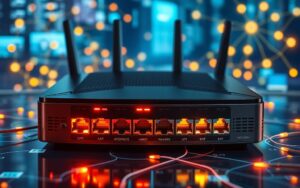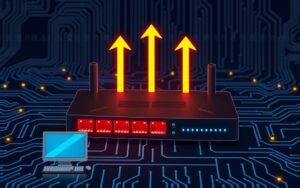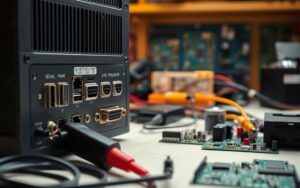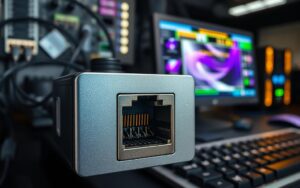Table of Contents
Finding the printer port on your computer is crucial for keeping your printer running smoothly. These ports are key for letting your computer and printer talk to each other. This makes everything work well in both your home and office. It’s important for everyone, from individuals working alone to those handling many devices. Knowing where the printer port is can save you time and stop annoying problems.
This guide will show you how to find and use printer port settings to fix any issues with connecting. With various ports like USB and network ones, understanding them will make your printing better. We’re going to explore printer ports more and see how to make your printer setup the best it can be.
Understanding Printer Ports
Printer ports allow computers and printers to talk to each other. They’ve changed a lot, getting better over time. Knowing about different printer ports helps people use their printers more effectively.
What is a Printer Port?
A printer port links a printer with a computer. In the past, LPT (Line Print Terminal) connections were common. They used 25 pins for parallel connections. Then came USB ports in the mid-1990s, speeding things up. USB 2.0 and USB 3.0 can reach up to 5 gigabits per second, much faster than old ports.
The Importance of Printer Ports in Connectivity
Knowing how printer ports work is key for good printer connections. In offices, Ethernet ports connect printers to networks for easier use. Wireless printing has become popular, removing the need for wires. It offers comfort and easy access, with Wi-Fi and services like Google Cloud Print changing how we print. But, wrong printer port settings can mess up printing, so understanding them is important for smooth work.
Where is the Printer Port on My Computer
Finding the printer port on your computer can solve many issues. Older computers often have printer ports. Nowadays, devices usually have USB ports or connect wirelessly. Knowing about different printer ports helps users make the right choice.
Identifying Different Types of Printer Ports
USB ports are common in most computers for printer connections and might be labelled as USB001. However, some computers still have old-style printer ports. Printer ports move data up to 2 megabytes per second. This is much less than USB 3.0, which can handle 5 gigabits per second. For using older equipment, there are adapters to change USB to printer ports. These ports are often found at the computer’s back.
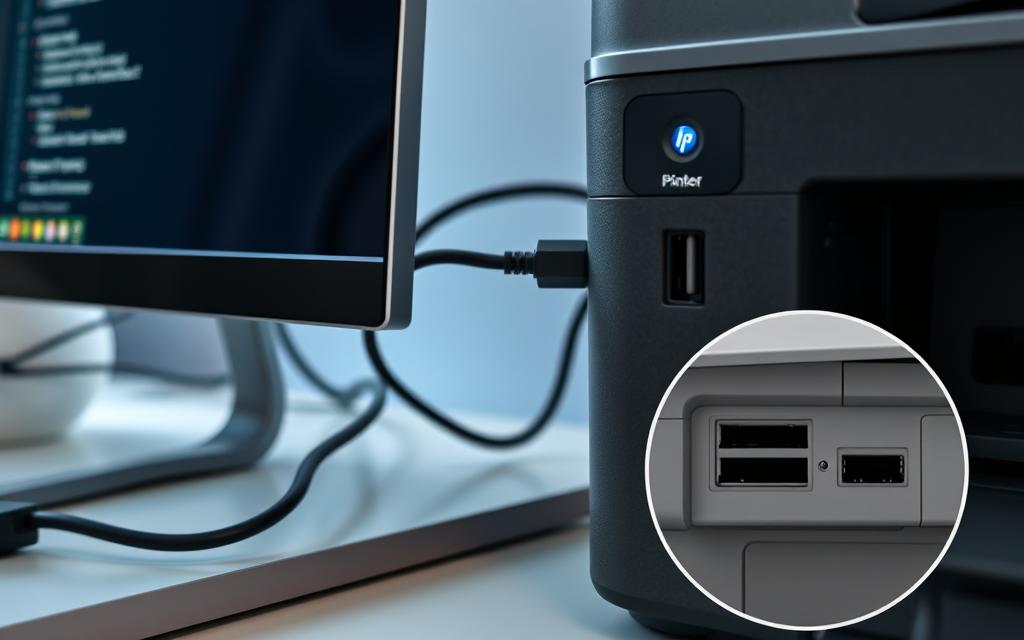
Common Issues with Printer Ports
USB printer connections can sometimes cause trouble. Issues may occur if the printer isn’t turned on before the computer. Users should check the device settings and ensure the drivers are up to date. Some also find that updating the BIOS and motherboard can fix problems.
To find printer ports and fix issues, it’s crucial to understand these connections. This knowledge improves how the printer works and the user’s experience. For more info, check out printer port types. Also, learn how to find USB ports on your device with this guide.
| Printer Port Type | Typical Use | Data Transfer Rate |
|---|---|---|
| USB | Modern printers and peripherals | Up to 5 Gbps |
| Parallel | Older printers | Up to 2 MBps |
| COM | Specialised devices like scanners | Varies |
| Network/Ethernet | Networked printers | Varies, generally faster than serial/parallel |
Accessing Printer Port Settings in Windows
Getting your printer to work smoothly with Windows is key. You’ll need to dive into system settings and use the Control Panel. It’s how you’ll fix common printer problems and make your printing better.
Step-by-Step Guide to Find Printer Ports
Here are the steps to find your printer port settings in Windows:
- Open the Start menu and select Settings.
- Click on Devices, then pick Printers & Scanners.
- Choose your printer from the list and click on it.
- Click Manage, then Printer Properties.
- In the properties window, go to the Ports tab to see and manage the ports.
Utilising the Control Panel for Port Management
The Control Panel is crucial for handling printers. Here is how to manage printer ports effectively:
- Enter the Control Panel from the Start menu.
- Select Devices and Printers to see all printers.
- Right-click your printer and pick Printer properties.
- Find the Ports tab, where you can view and adjust printer ports.
- Use tools like the Print Management Console for more in-depth printer tasks.
Some users, about 2 out of 10, find it hard to access printer ports via WSD. Knowing these steps improves how you manage your printer. It also makes locating printer ports easier, especially if you’re using network tools or the web services in the Control Panel.
| Method | Description |
|---|---|
| Advanced IP Scanner | Quickly shows all network devices, including printers. |
| Print Management Console | Provides a single space to oversee printers and settings on Windows. |
| Fing Network Scan | Easily finds networked devices, pinpointing printer IPs. |
| Checking Control Panel | Directly access printer settings via the web services tab. |
Connecting USB Printers to Your Computer
Connecting a USB printer to your computer is usually simple. But you must ensure it’s done right for the computer to recognise the printer. Always check that the printer is turned on before connecting. This part of the guide will help you make sure the connection is correct and solve common issues with USB printer connections.
Ensuring Proper Connection for USB Printers
Follow these steps to connect a USB printer effectively:
- First, turn on the printer before plugging it into the computer.
- Plug the USB cable into both the printer and computer firmly.
- Let your computer automatically find the printer.
- If needed, download any drivers from the maker’s website.
- Check your computer’s settings to confirm the printer is connected.
If problems come up, it might mean there are issues with the USB connection that need special steps to fix.
Troubleshooting Common USB Printer Port Issues
Sometimes, even after you connect everything right, problems can happen. Here’s how to handle common troubles and get your printer working:
- Printer Not Recognised: Make sure your printer is on and connected well. Try restarting the printer and your computer if it doesn’t work.
- Driver Issues: If your printer won’t install on its own, look for the latest drivers on the maker’s website.
- Incorrect Port: Make sure your printer is set to use the right USB port in your computer’s settings.
- Power Supply: Check the printer’s power supply is okay and that the power cable is properly connected.
- USB Cable: Look over the USB cable for damage since a broken cable can cause problems.
Using these tips, you can connect USB printers and fix any connection problems. This guide will help you avoid common setup mistakes and ensure your printer works well.
| Issue | Solution |
|---|---|
| Printer not detected | Restart both printer and computer |
| Driver problems | Download latest drivers from manufacturer’s site |
| Incorrect USB port | Check printer settings in control panel |
| Power supply issues | Ensure power cable is connected and functional |
| Faulty USB cable | Replace with a new USB cable if damaged |
Utilising Wired and Wireless Printer Ports
Choosing between a wired and a wireless printer connection needs thought. Each has its benefits that affect how we use our devices. Wired connections are great for speed and stability. Wireless lets us connect from anywhere, making it ideal for many devices.
Differences Between Wired and Wireless Connections
Wired connections use USB cables for a fast and reliable link to the printer. They offer steady performance with less interference. On the other hand, wireless lets you print from several devices without cables. Setting it up might need extra steps like enabling wireless mode and checking connection info.
- Wired connections are quicker for transferring data.
- Wireless connections offer freedom and easy access from any device.
- Wireless setups might face connection issues, requiring proper network setup.
Managing Multiple Printers on One Computer
Handling several printers requires good organisation. Knowing how to manage wired or wireless links helps keep things running smoothly. The right setup lets you switch between printers without stress. Things to keep in mind include:
- Check each printer’s connection type for compatibility with your computer.
- Adjust your system’s settings to recognise every printer correctly.
- Keep an eye on all connections. This avoids mix-ups when you change settings or add new printers.
Follow these tips for better performance, making it easy to handle many printers. Below is a summary of key points and strategies for both connection types:
| Feature | Wired Printer Connection | Wireless Printer Connection |
|---|---|---|
| Connection Setup | Simple plug-and-play, minimal configuration needed | Needs setup on a wireless network and configuring settings |
| Speed | Usually quicker and more dependable | Speed can change with network conditions |
| Mobility | Restricted by cable length | Works with devices anywhere within network reach |
| Multiple Printers Management | Manually identifying connections is simpler | Clear names for each printer can prevent mix-ups |
Conclusion
Understanding how to find the printer port is key for great printer connections. There are various ways to connect, like USB, Ethernet, and Wi-Fi. Each serves different setups well. Solving common printer port problems also makes printing smoother.
Setting up and managing your printer ports well is crucial to avoid issues. Getting printers connected right, at home or work, boosts productivity. It’s always good to look for help and update printer drivers and software for the best performance.
This guide aims to help you enjoy trouble-free printing. With technology shaping our work, keeping printers well-connected is important for efficiency.
For extra tips on fixing USB ports, check out this detailed guide. It could really improve how your printer works.
FAQ
How can I locate the printer port on my computer?
To find the printer port, open the Control Panel. Then, click on Devices and Printers. Right-click your printer and choose Printer Properties. Click the Ports tab to see the ports.
What types of printer ports are available?
Common printer ports include USB, serial, and parallel ports. Each one has its own role in connecting the printer with the computer.
Why is it important to understand printer port settings?
Knowing printer port settings helps solve connectivity issues. It also ensures devices communicate well. This is vital for smooth printing, especially when many printers are used.
What are some common issues related to printer ports?
Users often face problems like disconnections and recognition failures. Sometimes USB ports don’t show up because the printer was off at startup. Fixing these issues can improve your printing.
How do I access printer port settings in Windows?
Access settings by clicking Start, then Settings, and choosing Devices. Go to Printers & Scanners. Here, manage ports by selecting Print Server Properties and finding the Port tab.
What should I do if my USB printer is not recognised?
Make sure the USB printer is on when connecting it. If unrecognized, try another USB port or check for updates in Device Manager.
What are the benefits of using wired versus wireless printer connections?
Wired connections are usually faster and more reliable. Wireless offers more flexibility, perfect for many devices. Your printing needs will guide your choice.
How can I manage multiple printers on one computer?
To handle many printers, assign each one its correct port. Use the Control Panel to adjust settings and solve any issues.
Can I change the printer port settings without additional software?
Yes, you can change settings via the Windows Control Panel. This lets you tweak printer configurations easily without extra software.


